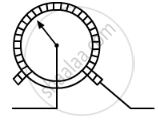Advertisements
Advertisements
Question
Use the data in the Table given below to answer the following –
Which among iron and mercury is a better conductor?
Table give below Electrical resistivity of some substances at 20°C
| Electrical resistivity of some substances at 20°C | ||
| − | Material | Resistivity (Ω m) |
| Conductors |
Silver | 1.60 × 10−8 |
| Copper | 1.62 × 10−8 | |
| Aluminium | 2.63 × 10−8 | |
| Tungsten | 5.20 × 10−8 | |
| Nickel | 6.84 × 10−8 | |
| Iron | 10.0 × 10−8 | |
| Chromium | 12.9 × 10−8 | |
| Mercury | 94.0 × 10−8 | |
| Manganese | 1.84 × 10−6 | |
| Alloys |
Constantan (alloy of Cu and Ni) |
49 × 10−6 |
| Manganin (alloy of Cu, Mn and Ni) |
44 × 10−6 | |
| Nichrome (alloy of Ni, Cr, Mn and Fe) |
100 × 10−6 | |
| Insulators | Glass | 1010 − 1014 |
| Hard rubber | 1013 − 1016 | |
| Ebonite | 1015 − 1017 | |
| Diamond | 1012 − 1013 | |
| Paper (dry) | 1012 | |
Solution
Resistivity of iron = 10.0 × 10-8 Ω
Resistivity of mercury = 94.0 × 10-8 Ω
Resistivity of mercury is more than that of iron. This implies that iron is a better conductor than mercury.
APPEARS IN
RELATED QUESTIONS
Two conducting wires of the same material and of equal lengths and equal diameters are first connected in series and then parallel in a circuit across the same potential difference. The ratio of heat produced in series and parallel combinations would be:
A copper wire has diameter 0.5 mm and resistivity of 1.6 × 10−8Ω m. What will be the length of this wire to make its resistance 10 Ω? How much does the resistance change if the diameter is doubled?
Why are copper and aluminium wires usually employed for electricity transmission?
Why are alloys commonly used in electrical heating devices? Give reason.
Distinguish between good conductors, resistors and insulators. Name two good conductors, two resistance and two insulators.
What is meant by the "resistance of a conductor" ? Write the relation between resistance, potential difference and current.
What will be the resistance of a metal wire of length 2 metres and area of cross-section 1.55 × 10−6 m2 if the resistivity of the metal be 2.8 × 10−8 Ω m?
Calculate the resistance of a copper wire 1.0 km long and 0.50 mm diameter if the resistivity of copper is 1.7 × 10−8 Ω m.
How does the resistance of a conductor depend on:
area of cross-section of the conductor?
What would be the effect on the resistance of a metal wire of:
increasing its length?
What would be the effect on the resistance of a metal wire of:
increasing its temperature?
How does the resistance of a wire change when:
its material is changed to one whose resistivity is three times?
The figure blow shows a variable resistor in a dimmer switch.

How would you turn the switch to make the lights: (a) brighter, and (b) dimmer? Explain your answer.
Resistance of a metal wire of length 5 m is 100 Ω . If the area of cross - section of the wire is `3 × 10^-7 "m"^2` , Calculate the resistivity of the metal .
How will you infer with the help of an experiment that the same current flows through every part of the circuit containing three resistors R1, R2 and R3 in series connected to a battery of V volts?
The element used almost exclusively for filaments of incandescent lamps:
A cylindrical conductor of length l and uniform area of cross-section A has resistance R. Another conductor of length 2l and resistance R of the same material has an area of cross-section:
Assertion: Conductors allow the current to flow through themselves.
Reason: They have free charge carriers.
